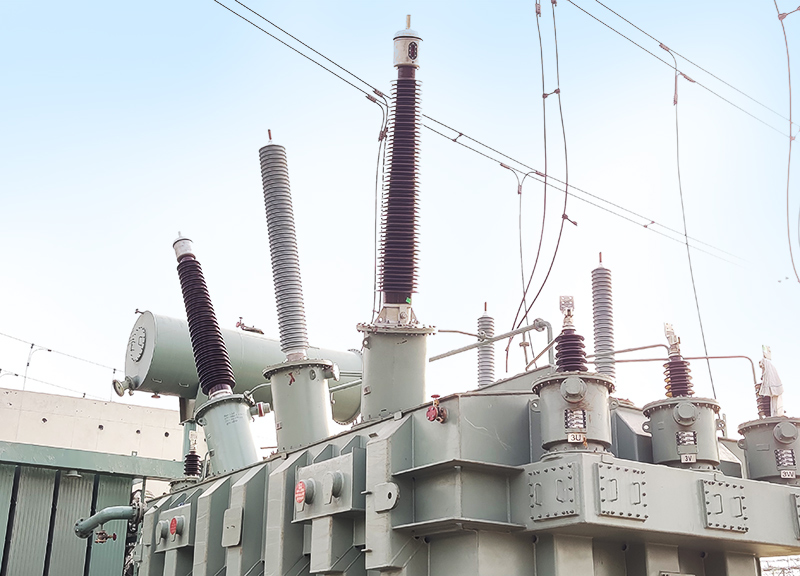 Transformer bushings are crucial parts of electrical transformers because they act as insulated conduits that allow wires to flow across barriers that are grounded. Through the prevention of electrical faults and preservation of the transformer's integrity, they guarantee the efficient and safe transfer of electricity. An extensive list of the essential components of a transformer bushing may be seen below.
Transformer bushings are crucial parts of electrical transformers because they act as insulated conduits that allow wires to flow across barriers that are grounded. Through the prevention of electrical faults and preservation of the transformer's integrity, they guarantee the efficient and safe transfer of electricity. An extensive list of the essential components of a transformer bushing may be seen below.
1. Flange
The structural foundation that fastens the bushing to the transformer tank is called the flange. It offers a secure mounting location and aids in keeping the bushing in alignment. Strong materials like steel or aluminum are usually used to make flanges in order to withstand mechanical strains.
2. Insulator
The purpose of the insulator, which is frequently composed of porcelain or composite materials, is to electrically insulate the transformer tank's conductor. It is made to withstand high voltage strains as well as external elements like pollution and temperature variations. For better performance in damp environments, the insulator is usually structured like a set of concentric ribs, or sheds. This increases the creepage distance.
3. Conductor
The conductor, which is the bushing's central component, is in charge of transporting the electrical current. Because of its superior conductivity, copper and aluminum are typically used to make it. The conductor is hollow to decrease weight and facilitate cooling, and it is positioned in the center of the bushing.
4. Capacitance Grading Foils
The bushing has layers of capacitance grading foils that are used to regulate the distribution of the electric field along the insulator's length. By guaranteeing a consistent voltage gradient, this grading lowers the possibility of an electrical discharge and raises the bushing's general dependability. Aluminum or graphite are some of the materials used to make these foils.
5. Oil or Resin Impregnated Paper (OIP/RIP)
Layers of paper impregnated with oil (OIP) or resin (RIP) within the bushing increase its dielectric strength and offer further insulation. By filling in the gaps in the paper, the impregnation procedure prolongs the life of the bushing and stops partial discharges.
6. Sealing Systems
Sealing systems are essential for keeping impurities and moisture out of the bushing. Usually, they consist of rubber or other elastomeric gaskets and O-rings. Sealing well keeps insulating oil or resin from leaking out and preserves the qualities of the inside insulation.
7. Terminal Connectors
The places on the bushing where it connects to external electrical circuits are called terminal connectors. Their purpose is to guarantee low-resistance and secure connections. These connectors can have facilities for clamped or bolted connections and are frequently composed of brass or copper.
8. Mounting Hardware
Bolts, nuts, and washers are examples of mounting hardware that are used to fasten the bushing to the transformer tank. In order to endure the mechanical and thermal stresses that arise during operation, this hardware needs to be robust and long-lasting.
9. Test Tap
Certain bushings have a feature called the test tap that enables diagnostic testing without turning off the transformer. It offers a way to gauge the bushing's capacitance and power factor, which helps with upkeep and condition monitoring.
10. Corona Shield
A conductive ring or guard is positioned in close proximity to high-voltage regions of the bushing to avert corona discharge, which has the potential to cause insulation deterioration. It guarantees a consistent electric field and contributes to the bushing's extended lifespan.
For the purpose of designing, using, and maintaining transformers, it is essential to comprehend the various parts of a transformer bushing. Every part has a distinct function in making sure the bushing operates dependably at high voltages. Ensuring the overall safety and efficiency of the electrical power system requires careful consideration, installation, and maintenance of these components.

 SURVEY
How Did You Hear About Us?
SURVEY
How Did You Hear About Us?



















 Transformer bushings are crucial parts of electrical transformers because they act as insulated conduits that allow wires to flow across barriers that are grounded. Through the prevention of electrical faults and preservation of the transformer's integrity, they guarantee the efficient and safe transfer of electricity. An extensive list of the essential components of a transformer bushing may be seen below.
Transformer bushings are crucial parts of electrical transformers because they act as insulated conduits that allow wires to flow across barriers that are grounded. Through the prevention of electrical faults and preservation of the transformer's integrity, they guarantee the efficient and safe transfer of electricity. An extensive list of the essential components of a transformer bushing may be seen below.








Comments